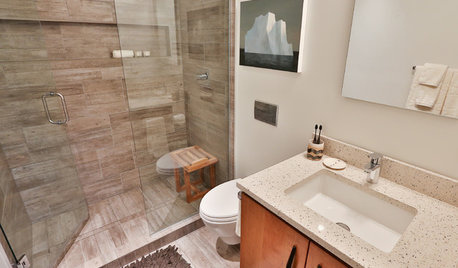diy furnace install - a/c question
darrenw
17 years ago
Featured Answer
Sort by:Oldest
Comments (40)
mechacc1
17 years agolast modified: 9 years agobob_brown
17 years agolast modified: 9 years agoRelated Discussions
Amana A/C and Furnace options
Comments (3)The answer depends on your climate and how much you use a/c and heat during the year. If the Amana contractor says your furnace is fine, that's good because he's not trying to sell you a furnace that you don't need. Replacing the a/c condenser with a matching coil would be a good choice. I wouldn't go any higher than a 14 SEER because you won't get the actual SEER rating with the current furnace fan. That Amana ASX14 has a lifetime compressor warranty. Make sure your regester it on Amana's website. Depending on your climate and utility rates, you could get a heat pump condenser instead of a straight a/c condenser. Heat pumps make cheap heat. A dual fuel system is a common set-up in many climates. Good luck. Here is a link that might be useful: Amana...See MoreAC/Furnace or A/C only?
Comments (3)Thank you. Existing furnaces are conventional motors, also about 14 years old and original with home. Electric Rates (excluding any adjustments): Basic Facilities Charge $22.50 Energy Charges*: Summer (June - October) All kWh $0.09970 Winter (November - May) First 1,000 kWh $0.09970 All other kWh $0.09476 NatGas Rates: Monthly Charge 10.00 Per Therm November-March 0.94019 April-October 0.84591 My gas bill rarely exceeds $100 (only 2 months this past winter) while my electric bill often exceeds $100 and usually $200 for at least a couple months of the year....See MoreUrgent advice needed on Furnace and A/C
Comments (7)"So, my questions are: - Is it common to have the furnace broken/to replace the igniter so often especially for a new furnace? What could have been wrong with the unit to cause this? Could we have gotten a faulty furnace unit?" * Yes, you could have gotten a bad batch from the mfr. They are warranted for 5 or 10 years, part only. Installation labor is typically 1 to 2 years as you know. - Is there anything we could do to to protect ourselves from having this happen and end up having to pay for the cost of repairing it on our own expenses in the near future if this keeps happening? * Yes, you could get a 10 year parts and labor warranty from the mfr for additional $$. Should cover everything (ask what it doesn't). - Also found that our Gibson a/c unit is making a loud noise/humming sound when it is running (i.e. air is blowing). Is that normal? It is bothering me because the units are on our deck right above our master bedroom. * The location of the units is the problem. Gibson units are basic, builder's grade. You'll hear even the quietest condensers when they run at night where they are located. " - When the a/c kicks in, I can hear a "sparks" like sound at the thermostat and also at the a/c unit at the start of the cycle - is that normal? I asked the contractor and the technician, they said it's normal but I have doubts." - You are hearing the 24 volt contacts in the thermostat energize to turn your system on. You may here several clicks: 1 for the fan, 1 for the furnace or air conditioning. "Anyway, I doubt we could get the developer to warrant or guarantee anything beyond 1 year given the "unusual" problems we have given a new furnace and a/c....I am sure the developer will not do much if anything because they will of course try not to incur more cost than they have to." - You are dead wrong on this. You sound like you already lost. You need to get the developer, a/c contractor, and system manufacturer (all 3) to get involved and solve your problem. Anything less and your problem will never be solved, and you'll complain about it as long as you're in the house. It's a new home and needs to be right. "I also just found out that our furnace units were not registered by the installer within 60 days after installation so we default to only 5 year manufacturer's warranty instead of 10 year warranty. Very very frustrated and upset about this!" - Call the mfr and fight it. Happens all the time in new construction. It's up to you to get that warranty. "Any advices will be greatly appreciated. THANK YOU!" - Start getting things done. - Complain a lot less. Good luck....See MoreReplacing 21 yr old Trane A/C -Furnace. Tiger/Ryan - Suggestions?
Comments (4)garyg, It is an either or situation XL14i with variable speed air handler, aluminum evaporator coil and Trane touch screen thermistat. Include 10 years parts and labor. No need to replace the lines because they are large enough. Heat Pump $ $9105 includes 2 -5K heat strips. or hybrid below 2 XL14i condensor with 2 Stage variable speed furnace $8208. XR13 with variable speed air handler, aluminum evaporator coil and Trane touch screen thermistat. Include 10 years parts and labor. No need to replace the lines because they are large enough. Heat Pump $ 7150 includes 2 5K heat strips. or XR13 condesory with 2 Stage variable speed furnace $6985. Gas rates are somewhat confusing for two reasong 1. They under reported July and caught in August. 2. we have distrubtion rate, gas supply rate,weather normalization adj rate, base rate adj and EE cost rate. All of which is different....See Moredarrenw
17 years agolast modified: 9 years agogeorgehvacnj
17 years agolast modified: 9 years agodarrenw
17 years agolast modified: 9 years agogeorgehvacnj
17 years agolast modified: 9 years agodarrenw
17 years agolast modified: 9 years agobk2000ext
17 years agolast modified: 9 years agonextwave
17 years agolast modified: 9 years agocalifornian
17 years agolast modified: 9 years agobob_brown
17 years agolast modified: 9 years agobk2000ext
17 years agolast modified: 9 years agofairyprincess
17 years agolast modified: 9 years agobob_brown
17 years agolast modified: 9 years agomr_havac
17 years agolast modified: 9 years agobk2000ext
17 years agolast modified: 9 years agofairyprincess
17 years agolast modified: 9 years agomr_havac
17 years agolast modified: 9 years agofairyprincess
17 years agolast modified: 9 years agobk2000ext
17 years agolast modified: 9 years agobob_brown
17 years agolast modified: 9 years agobrickeyee
17 years agolast modified: 9 years agofairyprincess
17 years agolast modified: 9 years agocookevillain_yahoo_com
16 years agolast modified: 9 years agodon21
16 years agolast modified: 9 years agotl_nix
16 years agolast modified: 9 years agojills007
16 years agolast modified: 9 years agogaryg
16 years agolast modified: 9 years agomr_havac
16 years agolast modified: 9 years agomr_air_guy
16 years agolast modified: 9 years agoenglewood1
16 years agolast modified: 9 years agomr_havac
16 years agolast modified: 9 years agoenglewood1
16 years agolast modified: 9 years agodon21
16 years agolast modified: 9 years agoagatto2
15 years agolast modified: 9 years agoagatto2
15 years agolast modified: 9 years agotim_tdhmechanical_com
12 years agolast modified: 9 years agoDIYwarrior456789
12 years agolast modified: 9 years agoMountain Springs HVAC
8 years ago
Related Stories

DOORS5 Questions to Ask Before Installing a Barn Door
Find out whether that barn door you love is the right solution for your space
Full Story
FENCES AND GATESHow to Install a Wood Fence
Gain privacy and separate areas with one of the most economical fencing choices: stained, painted or untreated wood
Full Story
REMODELING GUIDESSurvive Your Home Remodel: 11 Must-Ask Questions
Plan ahead to keep minor hassles from turning into major headaches during an extensive renovation
Full Story
MOST POPULAR8 Questions to Ask Yourself Before Meeting With Your Designer
Thinking in advance about how you use your space will get your first design consultation off to its best start
Full Story
REMODELING GUIDESConsidering a Fixer-Upper? 15 Questions to Ask First
Learn about the hidden costs and treasures of older homes to avoid budget surprises and accidentally tossing valuable features
Full Story
SELLING YOUR HOUSE15 Questions to Ask When Interviewing a Real Estate Agent
Here’s what you should find out before selecting an agent to sell your home
Full Story
DECORATING GUIDES8 Reasons to Jump Off the DIY Bandwagon
You heard right. Stop beating yourself up for not making stuff yourself, and start seeing the bright side of buying from others
Full Story
MATERIALSInsulation Basics: What to Know About Spray Foam
Learn what exactly spray foam is, the pros and cons of using it and why you shouldn’t mess around with installation
Full Story
BATHROOM DESIGNSee 2 DIY Bathroom Remodels for $15,500
A little Internet savvy allowed this couple to remodel 2 bathrooms in their Oregon bungalow
Full Story
HOUZZ TOURSMy Houzz: Elegant DIY Updates for a 1970s Dallas Home
Patiently mastering remodeling skills project by project, a couple transforms their interiors from outdated to truly special
Full Story



bk2000p_yahoo_com